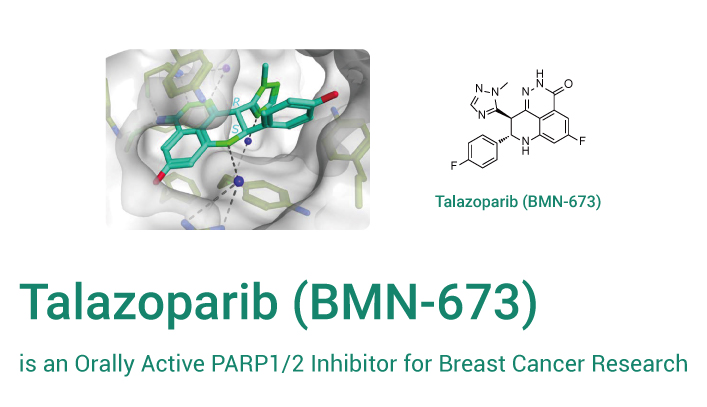Breast cancer is the second most common cancer in the world. Although survival rates are constantly improving because of the current strategies of primary/secondary prevention and the availability of innovative and personalized therapeutic challenges, breast cancer is still the most frequent malignant neoplasia and the leading cause of cancer-related lethality among women worldwide today. According to research data, at least 5% of unselected patients with breast cancer show loss-of-function mutations of BRCA1 and BRCA2. However, these BC susceptibility genes encode proteins critical for DNA homologous recombination repair (HRR). Hence, we will introduce a PARP1/2 inhibitor-Talazoparib (BMN-673).
Talazoparib is an orally active PARP1/2 inhibitor (Ki=1.2 nM/0.87 nM).
As a PARP1/2 inhibitor, Talazoparib is approved as monotherapies for deleterious/suspected deleterious germline BRCA-mutated, HER2-negative BC.
In vitro experiments, Talazoparib selectively targets tumor cells with BRCA1, BRCA2, or PTEN gene defects. For instance, Talazoparib shows EC50s of 0.3 nM, 5 nM and 0.31 for MX-1 cells (BRCA1 mutant), Capan-1 cells (BRCA2 mutant), and MRC-5 cells (normal). In addition, Talazoparib exhibits selective anti-tumor cytotoxicity and elicits DNA repair biomarkers at much lower concentrations than earlier generation PARP1/2 inhibitors (such as Olaparib, Rucaparib, and Veliparib).
In vivo, Talazoparib (0.33 mg/kg; i.g.; once daily for 28 days) exhibits antitumor activity against BRCA1 mutant breast cancer model in mice.
Morover, Talazoparib also exhibits favorable metabolic stability, oral bioavailability, and pharmacokinetic (PK) properties. Such as, Talazoparib exhibits moderate oral bioavailability (rat 56%) and Cmax (rat 7948 ng/mL) following oral administration (rat 10 mg/kg). In addition, Talazoparib exhibits a terminal elimination half-life (rat 2.25 h) due to plasma clearance (2 mL/min/kg) following intravenous administration (rat 5 mg/kg).
Of course, Talazoparib can also be used in combination with other anticancer agents. Synergistic or additive anti-tumor effects are also found when Talazoparib is combined with temozolomide, SN38 or platinum Agents.
All in all, Talazoparib represents a promising PARP1/2 inhibitor that is effective against breast and other cancers.
Reference:
[1] Wang B, et al. J Med Chem. 2016 Jan 14;59(1):335-57.
[2] Cortesi L, et al. Target Oncol. 2021 May;16(3):255-282.
[3] Shen Y, et al. Clin Cancer Res. 2013 Sep 15;19(18):5003-15.
